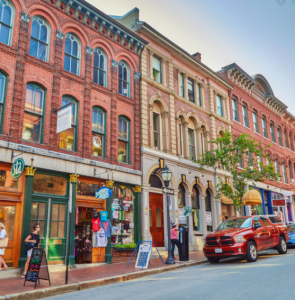Massachusetts
While Boston’s suburbs are on fire for some, rental woes are being seen for others in the Bay State. Melrose and Worcester break out of Q3 by being named among the Top-10 hottest real estate markets by Realtor.com. According to the report, houses are moving on an average of ~18 days, targeted by cash-conscious buyers as prices in Boston skyrocket. Additionally, the suburban locations provide easy commuting for workers, while giving the peace of mind of space in today’s COVID-conscious times. By contrast, Boston itself is seeing a rental crisis on the horizon. Gov. Charlie Baker has passed an executive order stipulating that no residential evictions can occur before Oct. 17, at the earliest; however, ~315K residents have “no confidence” that they can make August rent, according to a US Census Bureau survey. Landlords are seeing rental income dry up; Vida Urbana/City life projects ~33% of rental households facing evictions in the coming months, with new waves of sickness forecast for the late fall and early winter.
Connecticut
Southwestern Connecticut’s pre-pandemic real estate woes have temporarily been put on the back-burner as remote-working has allowed people to flee hard-hit New York City. March marked the beginning of the pandemic in the tri-state area as COVID-19 exploded, but the average sales price for an SFR in Fairfield County were up ~11.9% that month over the same period in 2019 (Vanity Fair). Additionally, the United States Postal Service reports that approximately 10K New Yorkers registered a new address in Connecticut over the last six months- a huge boon to investors who picked up long-term holds for cheap, as advised in the previous quarter amid the state’s uncertainty. After months of being locked indoors, 139 of 296 SFR sales occurred in June and July 2020 (Ridgefield Board of Realtors). In 2019, the entire state reported 327 sales; as of Sept. 1, there were already 296 closings on the year and on-target for 500 (Coldwell Banker). Even beyond southernmost Fairfield, other areas of the state are seeing a huge pickup in activity as remote work becomes permanent for many companies, meaning that this trend may be more permanent than fleeting.
New York
No state was impacted more by coronavirus than New York, particularly hard-hit NYC. Real estate has suffered greatly during the state’s phased reopening, particularly the commercial sector. With restaurants in the city still closed for indoor dining until Oct. 1., and the exodus of workers since “work from home” became the norm, workers have failed to return to the city. Nearly 90% of restaurants could not pay rent in full in August 2020 (Eatery.com). Office space leases are down ~20% from 2019; more office space is now available than at any point in the last 10 years (Colliers). While some industries delay returns to the office, citing cost-saving measures, others prove the office market isn’t dead yet: Facebook and Amazon recently inked deals for new office space in Manhattan; Blackstone is attempting to lure people back to the office by hiring car service for those apprehensive about mass transit; though Google’s formal policy does not require employees to return to the office until Summer, 2021, around 40% of the office has returned. Assuming that the situation does not deteriorate once again to a full lockdown, this sector of the commercial market may have seen the worst of the pandemic.
Interestingly, not all boroughs suffered equally, nor have areas of Long Island. Manhattan saw a huge inventory increase of 24% in August- the highest total number of homes available in over a decade (New York Post). Sale contracts also fell 6%, showing that the pending market looks no better. Meanwhile, areas of Queens and Brooklyn are on fire: Astoria/Long Island City saw a near ~25% sales increase, a record figure (Street Easy). Brooklyn saw an increase of almost ~39% in August as compared to August 2019. While for some, the outer boroughs provided refuge, for others, the exurbs and suburbs beckoned. Long Island saw the largest home price increases since 2018 over the last few months (OneKey MLS). Pending sales soared over 42% in both Nassau and Suffolk as compared to the same period last year, but inventory dropped in both counties by over ~20%.
Investment sales hit the skids in all boroughs; from January through June, the market saw a 45% decline in sales- translating to $9.65B, according to Ariel Property Group. However, given the figures above, compounded by the new CDC order, it is likely that inventory remains tied up by those in arrears on either rents or mortgages. Come the new year, it will be interesting to see if a pandemic-related bubble has been created on home values, and how much activity will be taken on by investors at auctions and short sales.
 New Jersey
New Jersey
Second-hardest hit after its neighbor, New Jersey is still managing to see growth. Sale prices are up over 11% (Bloomberg). Interestingly, the largest jump came in Atlantic/Hammonton, decidedly South Jersey- potentially as people seek out vacation homes near the shore. Proximity to two major cities- 1 hour to Philadelphia, 2 hours to NYC- likely also factor into the equation, just far enough to be away, but close enough to enjoy the remaining benefits of the metros. Further north, Hudson County- including Hoboken- are now in demand, just a short ferry ride or train away from Manhattan. Importantly, rent has remained virtually flat, making it a haven for affordability while rents elsewhere are skyrocketing. Most movers are between 25-50 years of age (NJ.com) and those moving into new buildings are mostly coming from Manhattan (Kushner Real Estate Group). On the whole, it seems like North Jersey is decidedly more stable than its New York counterparts, and a more balanced rental market. It will be interesting to see what happens to the Garden State when the moratorium’s end- should everything continue to hold, NJ may be a boomtown for investment opportunities in 2021.
Rhode Island
Rhode Island faced a housing supply crisis even before COVID, as SFR home sales were down ~19.7% since the second quarter of 2019, while the price increased over 4% in the same time span, with the median SFR price creeping above $300K for the first time (Rhode Island Association of Realtors). These issues are now being further exacerbated as the state becomes a safe haven for refugees from Boston and New York; Apartmentlist.com indicates that ~31% of new rental inquiries for Providence come from Bostonians; over ~12% is from NYC. In the second quarter of 2020, around 430 new SFR purchases were made by Massachusetts and New York buyers; helping to buoy the market temporarily, but as temporary layoffs turn permanent, Rhode Island could be looking at a foreclosure and/or eviction headache.
New Hampshire
Record-low mortgage rates, combined with the flight from larger cities for space, have led to a surprising “double-double” in New Hampshire; in May 2020, unemployment in NH was ~14.5% but home appreciation is above ~10% from 2019 (Laconia Daily Sun). With tight inventory, housing demand was strong throughout the state pre-pandemic, however, New Hampshire is 14th in the nation for attracting in-bound millennials (Smart Asset). A more technologically-friendly generation, combined with companies willing to transition to remote work permanently, the state looks to keep its strong real estate trends.
 Maine
Maine
Maine’s housing market is thus far unprecedented in terms of success, even in the throes of coronavirus. Home sales are just 1% behind pace from 2019 through the first 7 months of 2020; in July alone, sales are up ~12% year over year (WMTW ABC8). While South Portland ranks on the list of hottest locations in the country (Realtor.com), even rural areas of the state are seeing a spike in sales as people require more space and relative safety in the pandemic.
Pennsylvania
Two big stories are coming out of Pennsylvania’s real estate market in Q3. Firstly, as of Sept. 1, barring any further executive direction from the governor, landlords can begin eviction processes. While it remains to be seen how many will occur, about ~$381K of the state’s renters reported being behind on rent in July, per census data. Additionally, unlike some states where eviction proceedings can take months, PA’s process moves quickly: upon a claim being filed, a hearing must be set within 15 days, and once a judgment is rendered, a tenant must vacate the property within 21 days of the decision. That is bad news for landlords and renters alike. This information is compounded by the second story coming out of the state: in contrast to its northeastern counterparts, even as activity in the Philadelphia suburbs increases (up ~9%, according to Drexel University), prices there have fallen while rising in the city itself. In part, this may be a factor of limited housing inventory in the town-home heavy city, whereas other cities are more apartment-centric. Additionally, with prices even cheaper in the suburbs across the border in New Jersey, plus the rise of work from home culture, “suburbs” to Philadelphians no longer translates to Bucks, Delaware, or Montgomery Counties.


